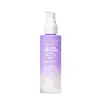What's inside
What's inside
 Key Ingredients
Key Ingredients

 Benefits
Benefits

 Concerns
Concerns

 Ingredients Side-by-side
Ingredients Side-by-side

Water
Skin ConditioningGlycerin
HumectantButyrospermum Parkii Butter
Skin ConditioningC12-15 Alkyl Benzoate
AntimicrobialPropanediol
SolventPolysilicone-11
C10-18 Triglycerides
EmollientCaprylic/Capric Triglyceride
MaskingPentaerythrityl Tetraisostearate
EmollientCetearyl Olivate
Sorbitan Olivate
EmulsifyingCetyl Alcohol
EmollientPhenoxyethanol
PreservativeCeramide NP
Skin ConditioningPolyacrylate-13
Hydrogenated Polyisobutene
EmollientEthylhexylglycerin
Skin ConditioningPolyglyceryl-10 Laurate
Skin ConditioningEthylhexyl Palmitate
EmollientLaureth-12
EmulsifyingSorbitan Isostearate
EmulsifyingHdi/Trimethylol Hexyllactone Crosspolymer
Polymethylsilsesquioxane
Citric Acid
BufferingSodium Hydroxide
BufferingWater, Glycerin, Butyrospermum Parkii Butter, C12-15 Alkyl Benzoate, Propanediol, Polysilicone-11, C10-18 Triglycerides, Caprylic/Capric Triglyceride, Pentaerythrityl Tetraisostearate, Cetearyl Olivate, Sorbitan Olivate, Cetyl Alcohol, Phenoxyethanol, Ceramide NP, Polyacrylate-13, Hydrogenated Polyisobutene, Ethylhexylglycerin, Polyglyceryl-10 Laurate, Ethylhexyl Palmitate, Laureth-12, Sorbitan Isostearate, Hdi/Trimethylol Hexyllactone Crosspolymer, Polymethylsilsesquioxane, Citric Acid, Sodium Hydroxide
Water
Skin ConditioningHelianthus Annuus Flower
Skin ConditioningAloe Barbadensis Leaf Juice
Skin ConditioningGlycerin
HumectantEthylhexyl Palmitate
EmollientGlyceryl Stearate
EmollientStearic Acid
CleansingGlyceryl Laurate
EmollientCeramide NP
Skin ConditioningCeramide AP
Skin ConditioningCeramide EOP
Skin ConditioningPhytosphingosine
Skin ConditioningCholesterol
EmollientPanthenol
Skin ConditioningPersea Gratissima Fruit Butter
EmollientTocopheryl Acetate
AntioxidantCalendula Officinalis Flower Extract
MaskingChamomilla Recutita Flower Extract
MaskingAlthaea Officinalis Flower Extract
EmollientSodium Hyaluronate
HumectantCocos Nucifera Fruit Juice
EmollientBeta-Glucan
Skin ConditioningAllantoin
Skin ConditioningTheobroma Cacao Seed Butter
EmollientXanthan Gum
EmulsifyingSodium Lauroyl Lactylate
EmulsifyingCarbomer
Emulsion StabilisingDiheptyl Succinate
EmollientCapryloyl Glycerin/Sebacic Acid Copolymer
Skin ConditioningPhenoxyethanol
PreservativeEthylhexylglycerin
Skin ConditioningWater, Helianthus Annuus Flower, Aloe Barbadensis Leaf Juice, Glycerin, Ethylhexyl Palmitate, Glyceryl Stearate, Stearic Acid, Glyceryl Laurate, Ceramide NP, Ceramide AP, Ceramide EOP, Phytosphingosine, Cholesterol, Panthenol, Persea Gratissima Fruit Butter, Tocopheryl Acetate, Calendula Officinalis Flower Extract, Chamomilla Recutita Flower Extract, Althaea Officinalis Flower Extract, Sodium Hyaluronate, Cocos Nucifera Fruit Juice, Beta-Glucan, Allantoin, Theobroma Cacao Seed Butter, Xanthan Gum, Sodium Lauroyl Lactylate, Carbomer, Diheptyl Succinate, Capryloyl Glycerin/Sebacic Acid Copolymer, Phenoxyethanol, Ethylhexylglycerin
 Reviews
Reviews

Ingredients Explained
These ingredients are found in both products.
Ingredients higher up in an ingredient list are typically present in a larger amount.
Ceramide NP is a type of ceramide.
Ceramides are intercellular lipids naturally found in our skin that bonds dead skin cells together to create a barrier. They are known for their ability to hold water and thus are a great ingredient for dry skin.
Ceramides are an important building block for our skin barrier. A stronger barrier helps the skin look more firm and hydrated. By bolstering the skin ceramides act as a barrier against irritating ingredients. This can help with inflammation as well.
If you would like to eat ceramides, sweet potatoes contain a small amount.
Read more about other common types of ceramides here:
Ceramide AP
Ceramide EOP
Ethylhexyl Palmitate, also known as octyl palmitate, is created from 2-ethylhexyl alcohol and palmitic acid. It is a fatty acid ester.
The fatty acid content of Ethylhexyl Palmitate makes it an emollient. Emollients help soften and hydrate your skin by trapping moisture within.
Ethylhexyl Palmitate is also used to help improve the texture of cosmetics. It helps other ingredient dissolve in products and help disperse ingredients more evenly.
You'll likely find this ingredient in sunscreen, as it is often used to mix UV-blocking ingredients such as avobenzone and ethylhexyl triazone.
It can also help stabilize the fragrances in a product as a fragrance fixative.
Ethylhexyl Palmitate can be used to substitute mineral oil.
Due to its high fatty acid content, it may not be fungal-acne safe.
Learn more about Ethylhexyl PalmitateEthylhexylglycerin (we can't pronounce this either) is commonly used as a preservative and skin softener. It is derived from glyceryl.
You might see Ethylhexylglycerin often paired with other preservatives such as phenoxyethanol. Ethylhexylglycerin has been found to increase the effectiveness of these other preservatives.
Glycerin is already naturally found in your skin. It helps moisturize and protect your skin.
A study from 2016 found glycerin to be more effective as a humectant than AHAs and hyaluronic acid.
As a humectant, it helps the skin stay hydrated by pulling moisture to your skin. The low molecular weight of glycerin allows it to pull moisture into the deeper layers of your skin.
Hydrated skin improves your skin barrier; Your skin barrier helps protect against irritants and bacteria.
Glycerin has also been found to have antimicrobial and antiviral properties. Due to these properties, glycerin is often used in wound and burn treatments.
In cosmetics, glycerin is usually derived from plants such as soybean or palm. However, it can also be sourced from animals, such as tallow or animal fat.
This ingredient is organic, colorless, odorless, and non-toxic.
Glycerin is the name for this ingredient in American English. British English uses Glycerol/Glycerine.
Learn more about GlycerinPhenoxyethanol is a preservative that has germicide, antimicrobial, and aromatic properties. Studies show that phenoxyethanol can prevent microbial growth. By itself, it has a scent that is similar to that of a rose.
It's often used in formulations along with Caprylyl Glycol to preserve the shelf life of products.
Water. It's the most common cosmetic ingredient of all. You'll usually see it at the top of ingredient lists, meaning that it makes up the largest part of the product.
So why is it so popular? Water most often acts as a solvent - this means that it helps dissolve other ingredients into the formulation.
You'll also recognize water as that liquid we all need to stay alive. If you see this, drink a glass of water. Stay hydrated!
Learn more about Water